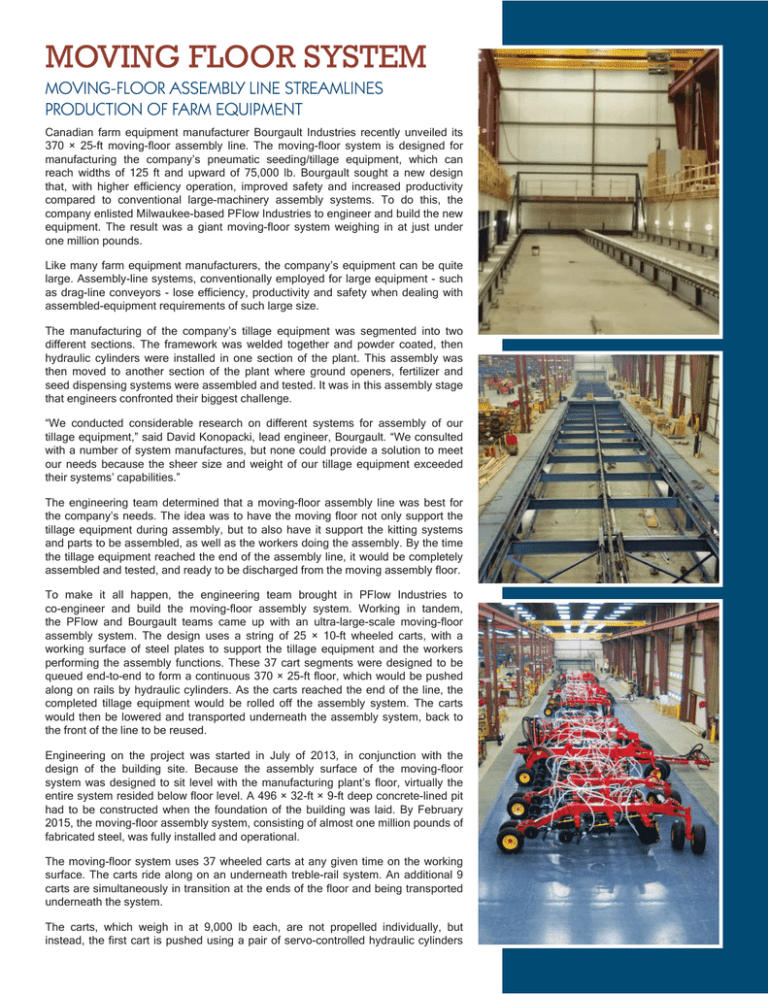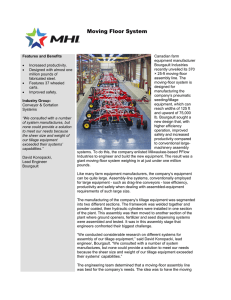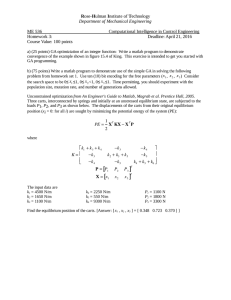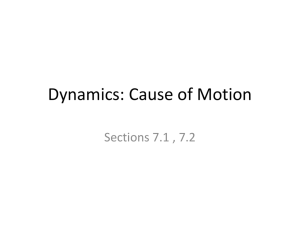MOVING FLOOR SYSTEM MOVING-FLOOR ASSEMBLY LINE STREAMLINES PRODUCTION OF FARM EQUIPMENT
advertisement

MOVING FLOOR SYSTEM MOVING-FLOOR ASSEMBLY LINE STREAMLINES PRODUCTION OF FARM EQUIPMENT Canadian farm equipment manufacturer Bourgault Industries recently unveiled its 370 × 25-ft moving-floor assembly line. The moving-floor system is designed for manufacturing the company’s pneumatic seeding/tillage equipment, which can reach widths of 125 ft and upward of 75,000 lb. Bourgault sought a new design that, with higher efficiency operation, improved safety and increased productivity compared to conventional large-machinery assembly systems. To do this, the company enlisted Milwaukee-based PFlow Industries to engineer and build the new equipment. The result was a giant moving-floor system weighing in at just under one million pounds. Like many farm equipment manufacturers, the company’s equipment can be quite large. Assembly-line systems, conventionally employed for large equipment - such as drag-line conveyors - lose efficiency, productivity and safety when dealing with assembled-equipment requirements of such large size. The manufacturing of the company’s tillage equipment was segmented into two different sections. The framework was welded together and powder coated, then hydraulic cylinders were installed in one section of the plant. This assembly was then moved to another section of the plant where ground openers, fertilizer and seed dispensing systems were assembled and tested. It was in this assembly stage that engineers confronted their biggest challenge. “We conducted considerable research on different systems for assembly of our tillage equipment,” said David Konopacki, lead engineer, Bourgault. “We consulted with a number of system manufactures, but none could provide a solution to meet our needs because the sheer size and weight of our tillage equipment exceeded their systems’ capabilities.” The engineering team determined that a moving-floor assembly line was best for the company’s needs. The idea was to have the moving floor not only support the tillage equipment during assembly, but to also have it support the kitting systems and parts to be assembled, as well as the workers doing the assembly. By the time the tillage equipment reached the end of the assembly line, it would be completely assembled and tested, and ready to be discharged from the moving assembly floor. To make it all happen, the engineering team brought in PFlow Industries to co-engineer and build the moving-floor assembly system. Working in tandem, the PFlow and Bourgault teams came up with an ultra-large-scale moving-floor assembly system. The design uses a string of 25 × 10-ft wheeled carts, with a working surface of steel plates to support the tillage equipment and the workers performing the assembly functions. These 37 cart segments were designed to be queued end-to-end to form a continuous 370 × 25-ft floor, which would be pushed along on rails by hydraulic cylinders. As the carts reached the end of the line, the completed tillage equipment would be rolled off the assembly system. The carts would then be lowered and transported underneath the assembly system, back to the front of the line to be reused. Engineering on the project was started in July of 2013, in conjunction with the design of the building site. Because the assembly surface of the moving-floor system was designed to sit level with the manufacturing plant’s floor, virtually the entire system resided below floor level. A 496 × 32-ft × 9-ft deep concrete-lined pit had to be constructed when the foundation of the building was laid. By February 2015, the moving-floor assembly system, consisting of almost one million pounds of fabricated steel, was fully installed and operational. The moving-floor system uses 37 wheeled carts at any given time on the working surface. The carts ride along on an underneath treble-rail system. An additional 9 carts are simultaneously in transition at the ends of the floor and being transported underneath the system. The carts, which weigh in at 9,000 lb each, are not propelled individually, but instead, the first cart is pushed using a pair of servo-controlled hydraulic cylinders that propel the entire line of carts. Each pusher incorporates position feedback that is fed to a PID servo-hydraulic controller enabling precise control of position, velocity and acceleration of each pusher. While the first pusher moves the string of carts at a constant speed, the second pusher extracts the next cart from a front-end vertical lift (bringing returning carts up from below the system), accelerating it to catch up to the moving line of carts. The second pusher matches the speed of the line and ultimately takes over, moving the entire line at the same established speed. Once the second pusher has control, the first pusher returns to the front end of the string of carts and then takes over moving the string again. The second cylinder now moves to extract the next cart from the front-end vertical lift and accelerates it to catch up to the moving line of carts. This sequence of synchronized handoffs between the two hydraulic pushers is repeated over and over to continuously move the floor surface. “This synchronized handoff of the hydraulic pushers is a key feature of the design,” said Mark Webster, VP of engineering at PFlow. “We looked at many different ways of accomplishing the movement of the floor. The tillage machines impose multiple 20,000-lb point loads to the moving surface. Because of this, and other characteristics, conventional assembly line systems, such as tow conveyors or flat-top conveyors, were quickly ruled out as options.” “Each cart contacts adjacent carts at a single contact point, midpoint of the width,” he continued. “This arrangement allows each individual cart to follow the rails in sequence, eliminating the need for highly accurate rail alignment and adjustment of contact points. The carts remain in contact entirely due to the backpressure created by the normal friction in the system. Deceleration of the moving floor is precisely controlled to be less than the normal deceleration due to friction, such that the carts never lose contact with each other during normal operation.” The speed of the moving floor is user-selectable, ranging between 0.125 and 3.25 ft/min, effectively taking between 1.75 and 45 hours for the floor to make a full transition. Although the system has just gone into operation, Bourgault estimates a productivity increase of 30%, due in large part to the ability to stage components and materials along the line at the specific point when they are needed, and to have them travel along with the tillage equipment. PFlow Industries | 6720 N. Teutonia Ave., Milwaukee, WI 53209 | (414) 352-9000 p | (414) 352-9002 f | www.pflow.com | info@pflow.com





